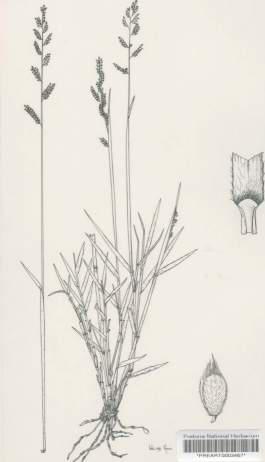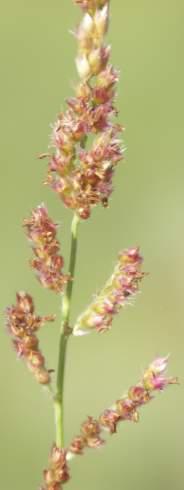Brachiaria serrata
Brachiaria serrata (Thunb.) Stapf
Family: Poaceae
Common names: red top grass, velvet signal (Eng.) ; rooisinjaalgras (Afr.)
Introduction
Brachiaria serrata is a perennial grass with bright green leaves and red or purplish-red spikelets covered in silky hairs.
Description
Description
Brachiaria serrata is a densely or loosely tufted rhizomatous perennial grass, 300-750 mm high, with the vegetative parts very variable and the basal sheath silky hairy. The culms (stems) are single or profusely branched. Leaves form a dense tuft at the base or are cauline leaving the base bare.

The leaf blade is 50-250 x 2-10 mm, the leaf margin is ± cartilaginous, white and usually crinkled; the ligule is a fringe of hairs. The raceme is 10-25 mm long, secund; rachis less than 1 mm wide, solid, triquetrous or crescentric, sometimes narrowly winged; the spikelets cover the whole length of the rachis, arranged in two rows; the pedicels are of equal length. The spikelet is 2.3-4.5 mm long, stipe absent, with dense, long, silky, white or purple hairs concentrated at the apex; the lower glume (the bracts at the base of the spikelet) is half as long as the spikelet and not separated from the upper lemma by an internode, and is 3-nerved; the lower lemma is acute or rounded, with a short stout mucro or awn up to 1.5 mm long and the lower palea is similar; the upper lemma, which encloses the grass flower, is ovate, striate, acute, rugulose; the anther is 1.0-2.5 mm long.

Flowering time: October to May.
Conservation Status
Status
The SANBI Threatened Plants Programme has not as yet indicated its conservation status, but so far Brachiaria serrata is common in most areas. It is good for grazing so conservation is practised indirectly.
Distribution and habitat
Distribution description
In South Africa Brachiaria serrata is widespread and also occurs northwards into tropical Africa, where it is commonly a species of open savanna woodland that extends into grassland, and sometimes to vlei edges; occasionally, it is a ruderal in disturbed areas and roadsides. In South Africa it seems to prefer rocky situations in relatively stable short grassveld, on shallow sandy soil, or on mountain slopes.
Derivation of name and historical aspects
History
Brachiaria is derived from the Latin word brachium, which means arm, the racemes being arm-like. The species name serrata is Latin for beset with teeth on the margin of the leaf blades. The genus Brachiaria has ± 100 species in the tropics, mainly Old World, with 21 species in southern Africa.
Ecology
Ecology
Brachiaria serrata occurs in a wide variety of vegetation types in South Africa, but never as a dominant species.
Uses
Use
Brachiaria serrata is an average grazing grass. It is reasonably palatable but has a relatively low leaf production and therefore is a pasture of average forage value. It may indicate good veld conditions in stony places or rangeland conditions.
Growing Brachiaria serrata
Grow
Brachiaria serrata is a summer growing species that flowers from October to May. It is slow-growing, but may form dense clumps where it becomes established. It is not reported to be cultivated at present and is only found growing naturally.
References
- Chippindall, L.K.A. & Crook, A.O. 1976. Grasses of southern Africa. Collins, Harare [Salisbury ].
- Gibbs Russell, G.E., Watson, L., Koekemoer, M., Smook, L., Barker, N.P., Anderson, H.M. & Dallwitz, M.J. 1990. Grasses of southern Africa. Memoirs of the Botanical Survey of South Africa No. 58.
- Leistner, O.A. (ed.). 2000. Seeds plants of southern Africa : families and genera. Strelitzia 10. National Botanical Institute, Pretoria.
- Van Oudtshoorn, F. 1999. Guide to the grasses of southern Africa. Briza Publications, Pretoria.
Credits
Aluoneswi Caroline Mashau
Pretoria National HerbariumGarden
May 2008
Plant Attributes:
Plant Type: Grass, Perennial
SA Distribution: Eastern Cape, Free State, Gauteng, KwaZulu-Natal, Limpopo, Mpumalanga, North West, Northern Cape, Western Cape
Soil type: Sandy
Flowering season: Spring, Early Summer, Late Summer, Autumn
PH:
Flower colour: Purple, Red
Aspect: Full Sun
Gardening skill:
Special Features:
Horticultural zones










Rate this article
Article well written and informative
Rate this plant
Is this an interesting plant?
Login to add your Comment
Back to topNot registered yet? Click here to register.